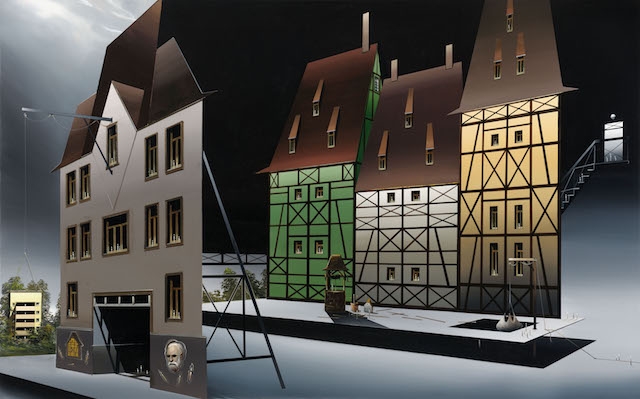Last year Titus Schade’s 2012 painting Der Kiosk came to life, turning into the full-size stage set now standing at a diagonal in the middle of the darkened gallery space. Created by Schade alongside theatre designer Marialena Lapata for a production of Austrian writer Elfriede Jelinek’s 1988 play Wolken.Heim, the set has previously been walked over by actors, voices bouncing around its timber frame. Audiences have gazed upon it, briefly participating in the illusion that it is a world unto itself. Here, an audio recording of a performance spills out from a concealed speaker, but now the stage set is unmistakably lifeless, much like the nocturnal scenes characteristic of the Leipzig painter’s work. Plateau gathers Der Kiosk along with 14 other paintings made between 2011 and 2018. Generally bodily in scale, these are dark screens, disquiet microcosms of another unpeopled world.
First performed in 1988, before Germany was unified, Jelinek’s difficult text fuses citations from the works of Martin Heidegger, Johann Gottlieb Fichte, Friedrich Hölderlin and other canonical German thinkers, alongside less easily reconcilable groups like the Red Army Faction. Uniting her handling of these sources is the question of German national identity, which, not least through a reverb-heavy refrain of ‘We’, becomes something entirely unstable and cacophonous. Schade’s exacting paintings, likewise, consistently feature diverse and perhaps still irreconcilable symbols of a German collective past (thatched cottages, pretty churches, windmills, GDR apartment blocks, clouds, the Romantic sublime), with these arrangements always bearing the mark of their construction and instability. His architectural scenes are themselves theatrical, unfurling on stacks or stagelike platforms. Outer limits are sharply defined, jutting out starkly from flat black or gradient voids. Precipitating a sense of vague but highly palpable dread, what exceeds or operates these limits remains unclear.
While Wolken.Heim lends itself constructively to Plateau, the inclusion of the stage set means the exhibition’s installation nears literalness. Schade’s paintings are dominated by ideas of theatricality, artifice and representation, but there is little need for them to be exhibited in a darkened theatrical space, or lit dramatically from above. Walking through the stage set, which we are invited to do, we actually become the actors deliberately and consistently excluded from Schade’s world. In place of human life, there small, uneasy details recur – orderly bonfires, bright moons, lighting candles, stacks of timber ready to be burnt – which give the sense of a strangely inhuman, symbolic language at work. As with a computer simulation or an architectural model, these appear included in an attempt to create a more ‘lived-in’ naturalism, which never quite takes.
Throughout Plateau, Schade’s distinct painterly style, a kind of 3D-printing hyperreal, is countered by a collagist’s handling of space, through which representation itself appears in a state of disassembly. Ominous flat geometric forms, for example in Die große Kultstätte (2012), emerge to shock pictorial space, disrupting any straightforward apprehension of the scene. Another small, seemingly incongruous painting included here, Regal Bauhaus (2011), shows a shallow shelving case, evocative of the letter cases (Setzkästen) traditionally gifted to German children for storing and displaying trinkets. Much like in Jelinek’s treatment of national identity, here identity is a careful process of inclusion and exclusion. What fails to make the cut, what doesn’t fully align, is just as important as the image that is finally offered up. Parsing for meaning in Schade’s strange pictorial language is then perhaps the wrong move. Probably the real issue is that other worlds, other pictures and arrangements, feel so close to hand.
Titus Schade: Plateau at Museum der bildenden Künste, Leipzig, 29 June – 26 August
From the September 2018 issue of ArtReview
